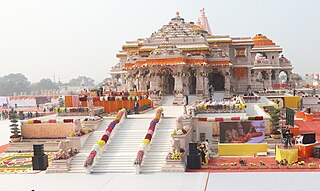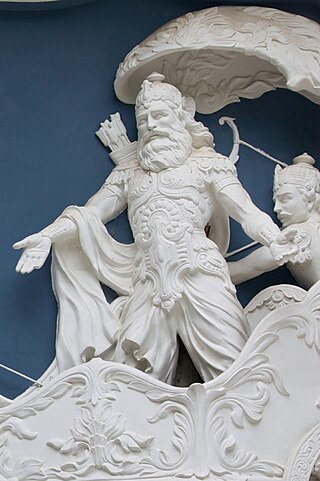Related Research Articles

Indian religions, sometimes also termed Dharmic religions or Indic religions, are the religions that originated in the Indian subcontinent. These religions, which include Buddhism, Hinduism, Jainism, and Sikhism, are also classified as Eastern religions. Although Indian religions are connected through the history of India, they constitute a wide range of religious communities, and are not confined to the Indian subcontinent.

Ayodhya is a city situated on the banks of the Sarayu river in the Indian state of Uttar Pradesh. It is the administrative headquarters of the Ayodhya district as well as the Ayodhya division of Uttar Pradesh, India.

Kshatriya is one of the four varnas of Hindu society and is associated with the warrior aristocracy. The Sanskrit term kṣatriyaḥ is used in the context of later Vedic society wherein members were organised into four classes: brahmin, kshatriya, vaishya, and shudra.
Shudra or Shoodra is one of the four varnas of the Hindu caste and social system in ancient India. Some sources translate it into English as a caste, or as a social class. Theoretically, Shudras constituted a class like workers.
Ram Janmabhoomi is the site that, according to Hindu religious beliefs, is the birthplace of Rama, the seventh avatar of the Hindu deity Vishnu. The Ramayana states that the location of Rama's birthplace is on the banks of the Sarayu river in a city called "Ayodhya". Modern-day Ayodhya is in the north Indian state of Uttar Pradesh. It is contested whether the Ayodhya mentioned in the Ramayana is the same as the modern city.

Abu al-Qasim Mahmud ibn Sabuktigin, usually known as Mahmud of Ghazni or Mahmud Ghaznavi, was Sultan of the Ghaznavid Empire, ruling from 998 to 1030. During his reign and in medieval sources, he is usually known by his honorific Yamin al-Dawla. At the time of his death, his kingdom had been transformed into an extensive military empire, which extended from northwestern Iran proper to the Punjab in the Indian subcontinent, Khwarazm in Transoxiana, and Makran.

The Somnath temple(IAST: somanātha) or Deo Patan, is a Hindu temple located in Prabhas Patan, Veraval in Gujarat, India. It is one of the most sacred pilgrimage sites for Hindus and is the first among the twelve jyotirlinga shrines of Shiva. It is unclear when the first version of the Somnath temple was built, with estimates varying between the early centuries of the 1st millennium and about the 9th century CE. The temple is not mentioned in the ancient Sanskrit texts of Hinduism; while various texts, including the Mahabharata and Bhagavata Purana, mention a tirtha at Prabhas Patan on the coastline of Saurashtra, where the temple is presently located, there is no evidence that a temple existed at the site in ancient times.

Romila Thapar is an Indian historian. Her principal area of study is ancient India, a field in which she is pre-eminent. Thapar is a Professor of Ancient History, Emerita, at the Jawaharlal Nehru University in New Delhi.
Hindu Temples – What Happened to Them is a two-volume book by Sita Ram Goel, Arun Shourie, Harsh Narain, Jay Dubashi and Ram Swarup. The first volume was published in the Spring of 1990.

Braj Basi Lal was an Indian writer and archaeologist. He was the Director General of the Archaeological Survey of India (ASI) from 1968 to 1972 and has served as Director of the Indian Institute of Advanced Studies, Shimla. Lal also served on various UNESCO committees.
The archaeology of Ayodhya concerns the excavations and findings in the Indian city of Ayodhya in the state of Uttar Pradesh, much of which surrounds the Babri Mosque location.

Ram Sharan Sharma was an Indian historian and Indologist who specialised in the history of Ancient and early Medieval India. He taught at Patna University and Delhi University (1973–85) and was visiting faculty at University of Toronto (1965–1966). He also was a senior fellow at the School of Oriental and African Studies, University of London. He was a University Grants Commission National Fellow (1958–81) and the president of Indian History Congress in 1975. It was during his tenure as the dean of Delhi University's History Department that major expansion of the department took place in the 1970s. The creation of most of the positions in the department were the results of his efforts. He was the founding Chairman of the Indian Council of Historical Research (ICHR) and a historian of international repute.
The National Council of Educational Research and Training (NCERT) is an apex resource organisation set up by the Government of India to assist and advise the central and state governments on academic matters related to school education. The model textbooks published by the council for adoption by school systems across India have generated controversies over the years. They have been accused of using Orwellian tactics to reflect the political views of the party in power in the Government of India. Recently it's been under scrutiny for saffronisation.

The Ayodhya dispute is a political, historical, and socio-religious debate in India, centred on a plot of land in the city of Ayodhya, Uttar Pradesh. The issues revolve around the control of a site regarded since at least the 18th century among many Hindus to be the birthplace of their deity Rama, the history and location of the Babri Masjid mosque at the site, and whether a previous Hindu temple was demolished or modified to create the mosque.

The Western Chalukyas were a prominent South Indian Kannadiga dynasty who ruled most of western Deccan India during the 10th century - 12th century. They are also known as Kalyani Chalukya after their capital at Kalyani, known today as Basavakalyan in Karnataka state. Later Chalukya is another commonly used name for this empire from the popular theory that they were related to the 6th century Chalukya dynasty of Badami.
Kishore Kunal is a former officer of the Indian Police Service from the state of Bihar, India. During his police career, he was appointed as the Officer on Special Duty (Ayodhya) by the prime minister V. P. Singh to mediate between the Vishwa Hindu Parishad and the Babri Masjid Action Committee on the Ayodhya dispute. He continued to serve in this position during the premierships of Chandra Sekhar and P. V. Narasimha Rao.
Ram Janmabhoomi Nyas is an organisation which was formed as a trust to promote and oversee the construction of a temple in Ayodhya, India at the Ram Janmabhoomi, the reputed site of the birth of the Hindu deity Rama. The Nyas was formed by members of the Vishva Hindu Parishad.
Dinanath Batra is the former general secretary of Vidya Bharati, the school network run by the Rashtriya Swayamsevak Sangh (RSS). He has also founded the educational activist organisations Shiksha Bachao Andolan Samiti and Shiksha Sanskriti Utthan Nyas.

Ayodhya is a legendary city mentioned in the ancient Sanskrit-language texts, including the Ramayana and the Mahabharata. These texts describe it as the capital of the Ikshvaku kings, including Rama.

Balak Ram is the primary murti (idol) of the Ram Mandir, a Hindu temple built in Nagara style at the location of Ram Janmabhoomi, the birthplace of the Hindu deity Rama, at Ayodhya, Uttar Pradesh, India, to commemorate the birth of Rama. The location is loaded, and the building of the mandir is controversial due to the demolition of a mosque formerly located at the place, and is an important subject of political debate in India.
References
- 1 2 "Membership of the Indian Council of Historical Research" (PDF). Archived from the original (PDF) on 3 March 2016. Retrieved 21 March 2015.
- ↑ The Hindu Net Desk (26 January 2020). "Full list of 2020 Padma awardees". The Hindu.
- ↑ "Being proud of India's Hindu past is great, but worry about the present too". The Financial Express .
- ↑ Khushwant Singh, Biased view (Book review of The Hindu Phenomenon), India Today, 31 August 1994.
- 1 2 Srinivas, M. N. (14 October 2000). Caste: Its 20Th Century Avatar. Penguin UK. p. 313. ISBN 9789351187837.
- ↑ "Members of the Council" (PDF). INDIAN COUNCIL OF HISTORICAL RESEARCH. Archived from the original (PDF) on 6 November 2019. Retrieved 6 November 2019.
- 1 2 3 Nussbaum, Martha Craven (2007). The Clash Within : Democracy, Religious Violence, and India's Future. Harvard University Press. ISBN 9780674030596. OCLC 1006798430.
- 1 2 3 "Alternative Narratives". The Book Review. Retrieved 11 May 2019.
- 1 2 Sundar, Nandini (2004). "Teaching to Hate: RSS' Pedagogical Programme". Economic and Political Weekly. 39 (16): 1605–1612. doi:10.1057/9781403980137_9. ISSN 0012-9976. JSTOR 4414900.
- ↑ Hawley, John Stratton (2015). "The Bhakti Movement and Its Discontents". A storm of songs. India and the idea of the Bhakti Movement. Harvard University Press. pp. 38–40. doi:10.4159/9780674425262. ISBN 9780674187467. JSTOR j.ctt1c84d6f. OCLC 917361614.
- ↑ Meenakshi Jain (21 March 2004). "Review of Romila Thapar's "Somanatha, The Many Voices of a History"". The Pioneer. Archived from the original on 18 December 2014. Retrieved 15 December 2014.